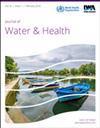Impact of abattoirs and local textile (Adire and Kampala) effluents on Yemoja River in Abeokuta, Nigeria
IF 2.5
4区 环境科学与生态学
Q3 ENVIRONMENTAL SCIENCES
引用次数: 0
Abstract
Discharge of untreated wastewater into water bodies pollutes the receiving waters. This study assessed the impact of abattoir and Kampala designers' effluent discharge on the water quality of the Yemoja River in Abeokuta, Nigeria. Twenty-seven water samples collected at three points, covering 180 m length, for 6 months were assessed for physicochemical parameters and metals and compared with the World Health Organization and Standard Organization of Nigeria permissible standards. Most discharge point levels were found to be higher than their corresponding upstream and downstream values. Temperature, turbidity, magnesium, alkalinity, DO, TSS, phosphate, lead, BOD and potassium were found to be in excess of normal levels for river water as prescribed by the World Health Organization and Standard Organization of Nigeria while parameters like TDS, TS, calcium, chloride, nitrate, sulphate, iron and COD were lower than the standards. The total coliform values were higher than both national and international permissible limits, indicating contamination by human sewage or animal droppings. The water quality index indicated polluted water that is unfit for consumption. Findings from this research indicate that butchering and tie-and-dye activities have impacted river Yemoja water quality. Therefore, wastewater from the abattoir and textile industries be treated before discharge into water bodies.屠宰场和当地纺织业(阿迪雷和坎帕拉)污水对尼日利亚阿贝奥库塔耶莫贾河的影响
向水体排放未经处理的废水会污染受纳水体。本研究评估了屠宰场和坎帕拉设计师排放的废水对尼日利亚阿贝奥库塔耶莫贾河水质的影响。研究人员在三个点收集了 27 份水样,长度为 180 米,历时 6 个月,评估了水样的理化参数和金属含量,并与世界卫生组织和尼日利亚标准组织的允许标准进行了比较。结果发现,大多数排放点的水平都高于其上游和下游的相应数值。发现温度、浊度、镁、碱度、溶解氧、总悬浮物、磷酸盐、铅、生化需氧量和钾超过了世界卫生组织和尼日利亚标准组织规定的河水正常水平,而总溶解氧、总悬浮物、钙、氯、硝酸盐、硫酸盐、铁和化学需氧量等参数则低于标准。总大肠菌群值高于国家和国际允许限值,表明受到人类污水或动物粪便的污染。水质指数表明,受污染的水不适合饮用。研究结果表明,屠宰和扎染活动影响了耶莫贾河的水质。因此,屠宰场和纺织业产生的废水应经过处理后再排入水体。
本文章由计算机程序翻译,如有差异,请以英文原文为准。
求助全文
约1分钟内获得全文
求助全文
来源期刊

Journal of water and health
环境科学-环境科学
CiteScore
3.60
自引率
8.70%
发文量
110
审稿时长
18-36 weeks
期刊介绍:
Journal of Water and Health is a peer-reviewed journal devoted to the dissemination of information on the health implications and control of waterborne microorganisms and chemical substances in the broadest sense for developing and developed countries worldwide. This is to include microbial toxins, chemical quality and the aesthetic qualities of water.
 求助内容:
求助内容: 应助结果提醒方式:
应助结果提醒方式:


